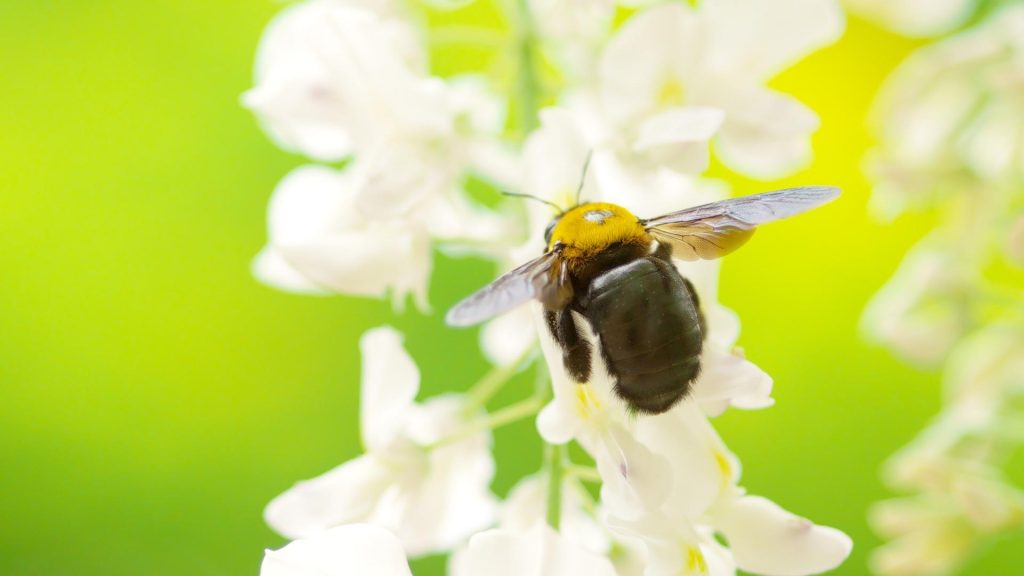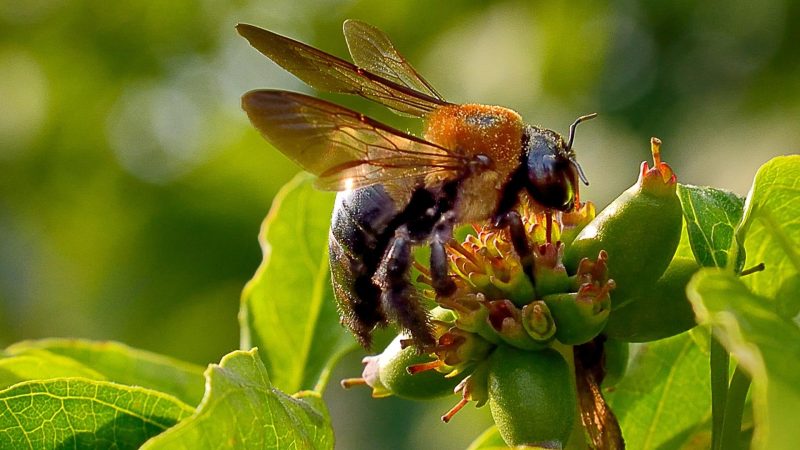Black carpenter bees are one of the largest species of bees and are often found in the Greater Houston area. They’re typically black in color, but some possess yellow markings on their head like the bumble bee.
But, what exactly is a black carpenter bee? The carpenter bee earned its name from its nesting behavior—which involves tunneling into hard plant material like bamboo or dead wood. As such, they weaken wood as well as leave stains and holes on surfaces, ultimately becoming nuisances.
In this article, you’ll know more about the activities of carpenter bees, their characteristics, as well as the various ways to get rid of them. On top of that, we’ll also include the scents they hate and many more!
Are Carpenter Bees Black?

Carpenter bee species are usually all black, but some possess yellow markings on their head like the bumble bees. Specifically, females are all black, while male bees have yellow faces and white dots on their heads.
Their lower abdomen has little to no hair, appearing shiny black, the reason they’re sometimes called black bees. However, compared to bees, their abdomen is shiny rather than fuzzy. Like bumble bees, the carpenter bees aid in pollinating plants, especially flowers and vegetables.
Related: Carpenter Bee and Bumblebee | Is There Any Difference?
What Do Black Carpenter Bees Do?
Adult carpenter bees drill tunnels in unpainted, dry, and weathered wooden objects like windowsills, doors, roof eaves, siding, beams, and more. You can treat, stain, or paint these things to prevent carpenter bees from destroying your wood items as the strong scent can repel the bees.
Are Black Carpenter Bees Bad?
Although carpenter bees don’t usually cause harm to you and your family, they can pose a threat to your house. Like termites, carpenter bees excavate into the wood, making tunnels that can weaken many vital structures in your home.
Moreover, females can sting but only when they’re bothered. Males also seem aggressive as they fly around pets and people, but they aren’t harmful since they don’t have a stinger.
Where Do Black Carpenter Bees Live?
Black carpenter bees commonly live on untreated nesting sites, such as rafters, eaves, decks, wooden shake roofs, fascia boards, and outdoor furniture like wooden chairs and tables.
Do Black Carpenter Bees Make Honey?
No, carpenter bees have over 730 species and none of them can make honey. This is because they belong to the subfamily Xylocopinae, which are not honey-producing species but are essential pollinators of crops, flowers, and plants.
How Big Does the Black Carpenter Bee Get?

The body length of an adult carpenter bee is approximately ½ of an inch to 1 inch or equal to 12.5 millimeters to 25 millimeters. Like other bees, female workers are smaller while males or drones are a tid bit smaller than queen bees.
Do Big Black Carpenter Bees Sting?
Only the female carpenter bees sting since the males don’t possess stingers. However, this is very rare and will happen only when you’re holding them or putting your fingers into their burrows.
How to Get Rid of Black Carpenter Bees?
To get rid of black carpenter bees effectively, you can use some of the given methods below:
Traps
- Step 1: Get a wooden box and drill at least ½ of an inch on each side of it.
- Step 2: Then, insert the plastic bottle’s opening in the hole of the box bottom, and suspend it from the box.
- Step 3: Lastly, hang the traps at each corner of your house, barn, or porch.
Once the bees enter the holes you’ve drilled into the box, they’ll fall into the plastic bottle, get trapped, and die eventually.
Paint Wooden Items
Another method you can try to get rid of carpenter bees is by applying paint on your bare wood. This will repel carpenter bees from nesting or destroying your wooden structures or items and save you from possible damages.
Furthermore, applying a permanent finish on your stripped wood can be a practical preventive solution. Carpenter bees don’t like to drill in painted wood as they can’t feel or see the grain of wood if it’s painted.
Replace Wood Materials
Another way to repel carpenter bees is by replacing wood with aluminum, vinyl, or other non-wooden materials. Carpenter bees don’t like any items if it isn’t made of wood.
Use Insecticides
Spraying hornet, wasp, or bee aerosol formulations into the drilled holes of carpenter bees is useful. To apply, lightly spray the interior of the tunnel’s entrance.
That way, the returning bee will disperse the compound of the insecticide spray into the tunnel passageway and die in the process. When using insecticides, make sure to follow the label directions to ensure your safety and get the best results.
Call a Pest Control Professional
If none of the above methods work, call a pest control professional and let their team of pest experts handle your carpenter bees issues. This way, you can ensure that your pest issues will be solved professionally and in a timely manner.
What Kills Carpenter Bees Instantly?
There are many items in the market today that kills carpenter bees instantly, and some of them are:
1. BioAdvanced 700420A Termite & Carpenter Bee Killer
The BioAdvanced 700420A Termite & Carpenter Bee Killer is one of the best-recommended products in killing carpenter bees and their nest. It’s best to apply the product during sunset when these insects are least active.
Make sure to wear also protective gear like:
- Gloves
- Socks
- Shoes
- Long pants
- Protective glasses
- A long-sleeved shirt or hoodie
- Scarf and hat
Whenever applying the spray to the nest, ensure to execute the application during the sunset as it’s the time where most carpenter bees are least active.
2. FenvaStar EcoCap
Another in-demand product for killing carpenter bees is the FenvaStar EcoCap . This bee killer is good for both indoor and outdoor use.
To use, shake the product well before using. Then, make a mixture by adding half the required water to the spray tank and adding the right amount of concentrate (read the product label for proper usage).
Stir and gradually add the remaining water. For one gallon of water, add 1 to 2 ounces of concentrate, and during the application, use a hand pump sprayer.
Note: Avoid excessive use and read the product label always for the right amount of application.
3. Hot Shot Wasp And Hornet Killer
This in-demand and effective product is non-staining and effectively kills hornets, wasps, yellow jackets, carpenter bees, scorpions, mud daubers, tent caterpillars, and more. It comes with a jet spray that can reach up to 27 feet, allowing you to spray far enough from the nest.
However, you still have to wear protective gear to ensure a safe and smooth application.
Related: Carpenter Bee Control: How To Get Rid of Carpenter Bees?
What Smell Does Carpenter Bees Hate?

Carpenter bees hate the smell of citronella oil, jojoba oil, lavender oil, and tea tree oil. You can also make a repellent from these essential oils by mixing them all, creating a strong scent that these bees loathe.
Once done with the mixture, spray it around the carpenter bees’ nest and in places where they usually hang out.
Related: Powerful Homemade Wasp and Bee Sprays (with Recipes)
How Do You Keep Carpenter Bees From Boring?
To stop carpenter bees from boring, varnish, or painting the bare wood surfaces in your home. This will make wood items less attractive to the carpenter bees.
It’s best to note that the most vulnerable areas are railings, windowsills, decks, doors, fences, eaves, and wooden lawn furniture. Make sure to cover the external openings of your residence with fine mesh screens or caulk the small cracks to prevent bee invasions.
How Long Do Carpenter Bees Stay Around?

Carpenter bees can live for up to one year. Each new generation is hatched every late summer and emerges from their nests in August and September. During these months, they feed, grow, and pollinate flowers as they go before settling in for the winter hibernation.
List of Sources
Bond, C., Buhl, K., & Stone, D. (2013). Citronella General Fact Sheet.
Grissell, E. E., Sanford, M. T., & Fasulo, T. R. (2017). Large Carpenter Bees, Xylocopa spp. (Insecta: Hymenoptera: Apidae: Xylocopinae).
National Pesticide Information Center. (2021). Selecting a Pest Control Company.
Potter, M. F. (2018). Carpenter Bees. University of Kentucky.
- Bed Bug Surge 2025: How to Detect, Prevent, and Safely Eliminate Infestations in Top U.S. Cities - June 18, 2025
- Asian Needle Ants Invade US Homes: 2025 Guide to Identification, Risks, and Effective Control - June 11, 2025
- New World Screwworm Alert: How US Livestock Owners Can Prevent Outbreaks and Protect Herds [Summer 2025 Update] - June 8, 2025
